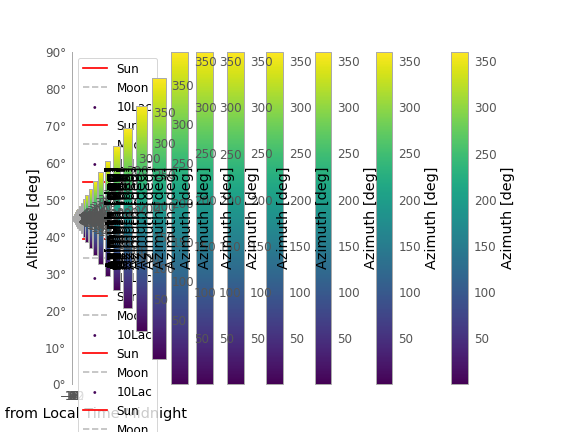Campaign details
This STAROS campaign is devoted to observing 10 Lacertae (HD 214680). This relatively bright star, of magnitude V=4.88, is a very hot object (36,000 K) and of spectral type O9V.
10 Lac is a star known to professional astronomers because it is a spectrophotometric standard used to calibrate ground-based and space-based astronomical instruments.
The star 10 Lac was also used to establish the MKK spectral classification. Some authors have noted rapid variations in the profile of certain lines.
We are proposing a low spectral resolution observation of this star in order to cover a large spectral range at once (the visible range at least).
How long ?
The STAROS 10 Lac campaign is scheduled over a 2-month period.
Visibility today at Paris

Why 10 Lac?
As already mentioned, the object is a spectrometric standard, which means that its spectral profile and flux are well known. If it's useful to professionals for calibrating instruments, it's also useful to amateurs.
That's why we're proposing this STAROS campaign. The astrophysical value of 10 Lac is low, but its observational value is very high. The character of this campaign is therefore that of a validation, particularly useful when working with a low spectral resolution spectrograph (R = 500 to 5000).
Properly observing 10 Lac means accurately assessing your instrument's response to the incident spectral flux, properly calibrating it in terms of wavelength and correctly operating your observing instrument. These are the cornerstones of your spectrographic work. By observing this star in a coordinated way with our different instruments, we'll be able, through comparisons, to refine the processing procedures of each and reveal any pitfalls that may arise.
It's worth pointing out that the spectrum of 10 Lac is very smooth, very useful for finding the instrumental response, and with relatively fine lines, very useful for finding the spectral calibration law. The spectrum is also very intense in the blue and ultraviolet, which will prove invaluable when observing with a spectrograph such as UVEX (Shelyak) and UVEX4 (Nice People).
What to observe with?
This campaign is aimed at owners of low-resolution spectrographs (between R = 500 and R = 5000), although it is sometimes possible to use this star to calibrate higher-resolution spectrographs.
The size and type of telescopes and scopes are irrelevant. In fact, it's this diversity that will be one of the riches of the campaign.
How to observe?
The aim is to learn how to properly calibrate your instrument or refine your technique. But what do you use to calibrate 10 Lac? Quite simply, with 10 Lac! We offer you the equivalent of a self-calibration, the star by itself, so to speak. But that's not quite how it works...
We have a reference spectrum (that of the professionals) and we try to ensure that the observed spectrum, after processing, matches the reference as closely as possible. It's not as simple as it sounds, but it's essential.
The reference spectrum is extracted from the CALSPEC database: https://www.stsci.edu/hst/instrumentation/reference-data-for-calibration-and-tools/astronomical-catalogs/calspec
It is also available in a form that can be used directly in the ISIS and specINTI software databases.
You can still download this spectrum by clicking just below, check it out, and try to get the same result with your own instrument!